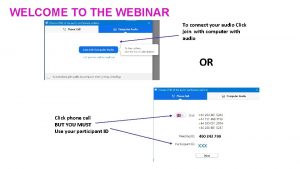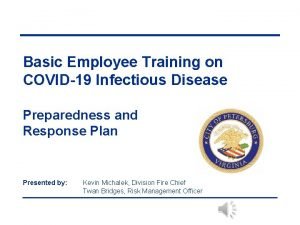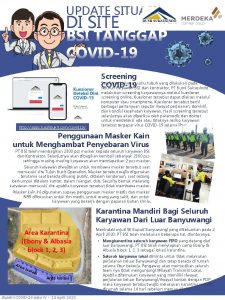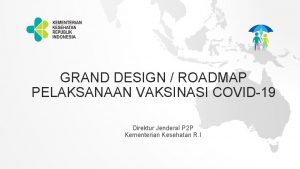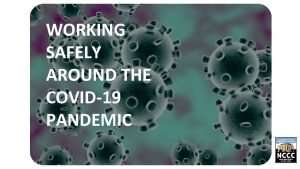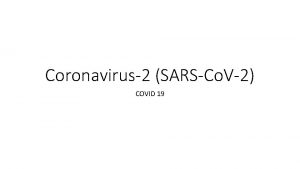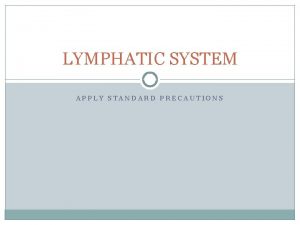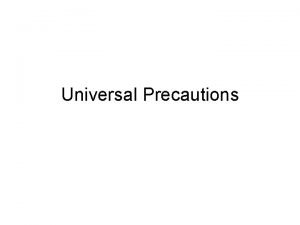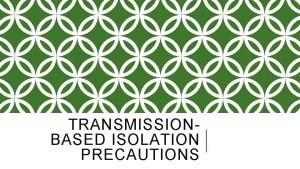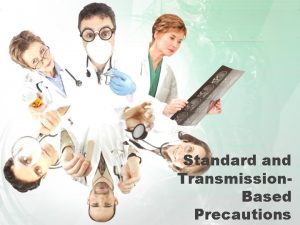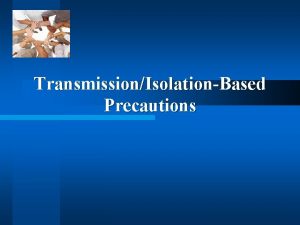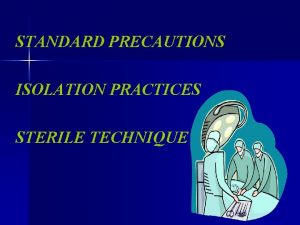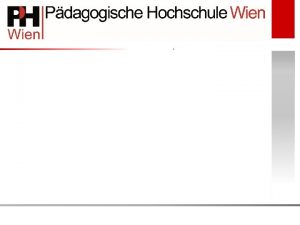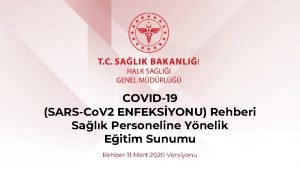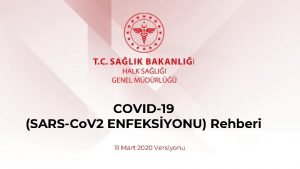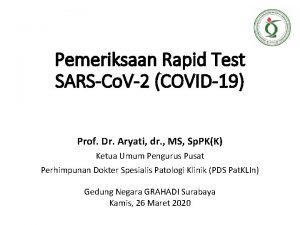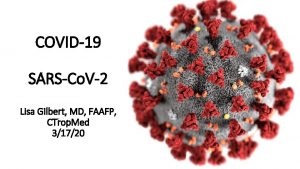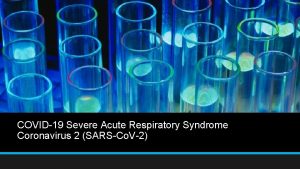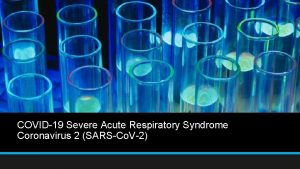COVID19 SARSCo V2 PRECAUTIONS FOR ENTs ENTs are


































- Slides: 34

COVID-19/ SARS-Co. V-2 PRECAUTIONS FOR ENT’s “ENT’s are in THE FRONT LINE!” This document (03/04/2020) might be subject to changes according to new evolutions and new informations and is only applicable during the current 2020 pandemic. Local hospital regulation should be taken into consideration Contributions: R. Kuhweide, L. Van Gerven, T. Van Zele, F. Indesteege, J. Meulemans, V. Vander poorten, Th. Somers, V. Topsakal, JB Watelet

COVID-19/ SARS-Co. V-2 PRECAUTIONS FOR ENT’s “ENT’s are in THE FRONT LINE!” : https: //www. bloomberg. com/opinion/articles/2020 -03 -24/the-coronavirus-crisis-isputting-surgeons-at-risktoo? fbclid=Iw. AR 3 Pj. RA 0 Zd. Flul. Nap. Gaa. Pt 1 Fx. ACte. Cnlx 8 L 5 Uwy_P 8 Ws. R 8 Vic. Uc. CYgw. Svc

GENERAL INFORMATION - virus survives at least 3 h probably up to 6 h in aerosol/droplets - droplets reach about 1 meter so keep your distance: 1½ meter whenever possible - virus survives 1 day on carton and 3 days on plastics & metals - virus survives up to 40 degrees Celsius - contamination occurs by droplets (speaking, sneezing, coughing) and/or via hands - contamination through nasal & buccal mucosa and conjunctiva

GENERAL INFORMATION - virus is inactivated within 1 minute by solutions with >62% alcohol, > 0, 5%H 2 O 2 or 0, 1% Na. OCl (sodium-hypochlorite, bleach, eau d’Javel, Carrel-Dakin) - surgical masks prevent droplet diffusion for 4 h - FFP-2 (NF 95) masks protect for contamination by droplets and can be continuously used for 8 h - “limited re-use” of FFP-2 masks is not recommended with Covid-19 yet is applicated in case of lack of supply - protective glasses, goggles, facial shields to protect eyes & face (see next slide) - gloves protect for contamination by droplets via hands - hands have to be disinfected after taking off gloves and/or between patients (as well as after WC, before meal and at hospital or home arrival) - FFP-3 masks are reserved for surgical interventions and procedures involving the airways

custom made facial shield : translucent firm plastic in A 4 punch four holes fix it on head light acknowledgements : Dr. B. Dulac (Fr) Dr. J. J. Garnir Dr. Th. Robillard

FURTHER GENERAL INFORMATION - Covid. Reference - COVID-19 informatie voor artsen (in Dutch)

EACH ENT SERVICE SHOULD CONVINCE ITS HOSPITAL DIRECTION / CRISIS TEAM / INFECTIOUS DISEASE DEPT THAT ENT IS AT HIGH RISK & NEEDS OPTIMAL PROTECTION every procedure involving airways proven Co. Vid(-) all other => Personal Protective Equipment = entire ENT, esp. w/ aerosolization surgical mask (preferably FFP 2/3) FFP 2/3 (no surgical mask !) double gloves splash goggles or facial shield waterproof gown disposable cap (sneezing & coughing reflexes, sprays, endoscopy, drilling)

Example of Personal Protective Equipment donning (ON) This example is no substitute of local hospital recommendations

Example of Personal Protective Equipment: duffing (OFF) This example is no substitute of local hospital recommendations

OTOLOGICAL EMERGENCY ACUTE OTITIS MEDIA complicated WITH 1) Mastoiditis : admission for IV antibiotics if ear is running: no grommet, if no discharge: consider paracenthesis screening for COVID monitoring (Upgrade to step 2 if no improvement within 24 h) 2) Mastoiditis + Subperiostal Abscess admission for IV antibiotics + grommet + incision & drainage of abscess screening for COVID monitoring (Upgrade to step 3 if no improvement in 24 h) 3) Mastoiditis + Subperiostal Abscess + Septic signs admission for IV antibiotics + grommet + incision & drainage of abscess perform a limited cortical mastoidectomy (see next slides for precautions)

OTOLOGICAL EMERGENCY - CONSIDER EAR AS RESPIRATORY MUCOSA and thus possibly contaminated - Treatment consists mainly in adequate IV antibiotics - Mastoidectomy is warranted when you risk intracranial complications - Surgery should only be performed by an experienced ENT - Maximum precautions in clothing (cfr see general info and endonasal surgery) - Minimum OR time with one goal: Drainage and offer some ventilation to the mastoid and middle ear (limited mastoidectomy and grommet) - Minimal and slow drilling, with curettage whenever possible - Cortical mastoidectomy can be done without microscope but use close fitting goggles for protection - Avoid microsuction with control hole

SURGICAL PRIORITY STRATIFICATION Priority level 1 a British Society of Otology Emergency - operation needed within 24 hours to save life Acute life-threatening complications of middle ear disease Button battery in external ear canal Priority level 1 b Urgent - operation needed with 72 hours note : Based on urgent / emergency surgery for life threatening conditions such as obstruction, bleeding and regional and / or localised infection & permanent injury / harm from progression of conditions Acute mastoiditis or other severe complications of middle ear disease not responding to medical therapy Traumatic facial nerve palsy, or Facial palsy secondary to cholesteatoma not responding to antibiotics and steroids Trauma to pinna Priority level 2 Surgery can be safely deferred for up to 4 weeks elective surgery with the expectation of cure note : Based on urgency of symptoms / complications / biological priority (expected growth rate) of individual cancers Cochlear implantation following meningitis Otologic neoplasia following discussion in MDT Baro-traumatic perilymph fistula Organic foreign bodies in the ear Priority level 3 Surgery that can be delayed for up to 3 months with no predicted negative outcome Cochlear implantation in pre-lingual profound hearing loss where delay will affect long term outcome Otologic neoplasia following discussion in MDT

SURGICAL PRIORITY STRATIFICATION Priority level 4 British Society of Otology Surgery that can be delayed for more than 3 months with no predicted negative outcome Cholesteatoma surgery where intra-cranial complication is not present or not likely to be imminent Surgery for chronic suppurative otitis media All ossicular surgery Middle ear implants Other cochlear implantation Grommets Tympanoplasty Meatopalsty Vestibular surgery Non-organic foreign bodies in the ear

RHINOLOGY 1. Outpatient clinic/consultation including nasal endoscopy 2. Surgery 3. Anosmia

1. Outpatient clinic/consultation including nasal endoscopy, patients with unknown COVID-19 status The following rhinologic procedures in the outpatient clinic should be considered as a high risk: • Interventional outpatient procedures on the upper aerodigestive tract, e. g. all endoscopies, nasal cautery, foreign body removal, biopsies, microbiology sampling. • Any intervention to patients with airway modifications – tracheostomy tube changes and laryngectomy patients. • Emergency care to ENT patients: acute tonsillitis, quinsy, epistaxis, foreign bodies, complications of acute sinusitis, other airway emergencies

1. Outpatient clinic/consultation including nasal endoscopy, patients with unknown COVID-19 status – Question all patients about respiratory symptoms and fever before clinical examination – Taking temperature is recommended – Consider all diagnostic procedures involving the upper airway as high risk – Reserve nasal endoscopy for urgent cases – Try to limit the amount of manipulation as much as possible (inspection versus debridement with suction and/or forceps) – Try to predict the necessary material and avoid leaving the consultation room with contaminated equipment – Consider whether to use or avoid topical decongestant and local anesthetic solution to reduces chances of sneezing and coughing during examination. If necessary use pledgets or cotton woal soaked in solution rather than spray – Use a tower with camera, screen and light source to avoid (too) close physical contact with the patient – Patients should wear masks in the waiting room, try to limit the waiting time as much as possible – Allow only essential staff in the consultation room (preferably one person) – Keep doors shut as much as possible

Why high risk? high viral shedding in the nasal cavity! Nasal cavity >> throat If viral particles become aerosolized, > 3 h in the air Viral shedding also in asymptomatic patients Lirong Zou et al. NEJM, 2020

Protective equipment for health care professionals performing nasal endoscopy (unknown COVID-19 status) • The following measures are recommended: – Patients: surgical mask before entry – Physicians: • • • hand-washing FFP 2 mask (=N 95) Nitrile gloves 2 x Cap Fluid-impermeable gown Splash goggles

2. Rhinological and endoscopic skull base surgery • Endoscopic endonasal surgery are considered as a high risk procedure for generating virus containing aerosols (esp when using lavages, powered instruments and drills) • Postpone elective surgery if possible • Preoperative testing for COVID-19 is advised. (Single or double test according to local availability. In the absence of confirmed negative status patients should be treated as positive. • Protective equipment for health care professionals in COVID-19+ patients or patients with unknown status : - FPP 2/N 95 mask - double gloves - facial mask or goggles - disposable cap - fluid impermeable gown Figure adapted from Romaguera et al. REC interv Cardiol 2020, for internal use only

2. Rhinological and endoscopic skull base surgery, for COVID-19 positive/symptomatic patients – postpone if possible – international recommendations: use PAPRs (Powered, Air Purifying Respirators) – video “COVID modifications in sinus and nasal surgery” (Melbourne) :

3. Sudden onset anosmia/hyposmia in COVID-19 infection • • • in Germany it is reported that more than 2 in 3 confirmed cases have anosmia ; in South Korea, where testing has been more widespread, 30% of patients testing positive had anosmia as their major presenting symptom in otherwise mild cases. given the potential for COVID-19 to present with anosmia, and the reports that corticosteroid use may increase the severity of infection, we would advise against the use of oral steroids in the treatment of new onset anosmia during the pandemic, particularly if it is unrelated to head trauma or nasal pathology (such as nasal polyps). initial treatment is decongestive (local and/or general) ; local steroids can be continued if used otherwise, but perhaps are better not initiated with new onset anosmia. spontaneous recovery seems to occur in the large majority. further information : Sixty seconds on. . . anosmia accepted for publication : Olfactory and Gustatory Dysfunctions as a Clinical Presentation of Mild to Moderate forms of the Coronavirus Disease

4. SCIT and COVID-19 crisis • • • guidelines of Dutch ENT & Allergology/Clinical-Immunology societies regarding patients treated with Sub. Cutaneous. Immuno. Therapy) no start ups discuss if SCIT can be replaced permanently or temporarily by SLIT SCIT can be stopped in all patients that have been treated for (almost) 3 years in the maintenance scheme the interval between 2 injections can be prolonged with 1 week, with a maximum of 8 weeks, without changing the dose

HEAD & NECK • • We reinforce the critical importance of appropriate personal protective equipment (PPE) in the safe management of patients with COVID-19. As the head and neck exam places the caregiver at heightened risk for potential COVID-19 infection from asymptomatic carriers, we recommend gloves, gown, masks and eye protection be worn in the examination of the upper aerodigestive tract as PPE availability allows. Elective and non-urgent outpatient visits should be postponed and innovative care approaches utilizing telemedicine should be explored and optimized. All elective and non-urgent surgery should be postponed.

OR Priority criteria for H&N Surgery during covid-19 Pandemic Proceed with surgery: - Squamous Cell Carcinoma HPV + or – - HNC Patients with complications of treatment (surgery or otherwise) - HNC recurrence after RT or RT/chemo failure.

OR Priority criteria for H&N Surgery during covid-19 Pandemic Proceed surgery Thyroid: - Anaplastic and medullary thyroid Ca. - Papillary thyroid Ca with suspicion for or identified metastases. - Large (>4 cm) follicular lesions. - Revision Papillary thyroid Ca with active progression of disease. - Parathyroidectomy with renal function declining. - Risk of airway obstruction. Skull base cancers requiring surgery. Salivary gland carcinoma. Skin cancer: melanoma, advanced staged SCC, BCC in critical areas.

OR Priority criteria for H&N Surgery during covid-19 Pandemic Consider postpone 30 days: Low-risk DTC( differentiated thyroid cancer) without metastasis. Postpone 30 -90 days ( or as long as needed) Goiter without airway compromise. Benign Thyroid nodules, Thyroiditis. Revision PTC stable or slow rate of progression. Parathyroidectomy with stable renal function. BCC where cosmetic impact is low even with further growth Benign salivary lesions.

Tracheostomy during covid-19 Pandemic Emergency tracheostomy: Manage patient as if he is Covid-19 positive. Elective tracheostomy: Always Covid-19 testing prior to procedure. If possible delay procedure until active Covid-19 has passed. Decision made by ENT and ICU consultants.

Tracheostomy during covid-19 Pandemic Surgical or open versus percutaneous procedure: Risk of shedding appears to be smaller in percutaneous but risk for the bronchoscopic controller! To be decided multidisciplinary ( ENT-Aneshesia. Bronchoscopist) after weighing pro-and cons. “It is recognized that many of these approaches will be local, influenced by epidemiologic and resource factors and that all our early experiences will be anecdotal, lacking the usual robust data on which we typically make decisions. ”

Standard operative procedure for tracheostomy in COVID 19 positive patient / Unknown status • Most skilled anaesthetic and ENT clinician performing anaesthetic and procedure, to ensure that the procedure is safe, accurate and swift • Reduce unnecessary team members to essential staff • Preparation and Gowning: 1. Use FFP 3 mask. 2. Eye/face protection should be worn for performing tracheostomy or changing a tracheostomy tube due to the risk of respiratory secretions or body fluids. One of the following options are suitable: 1. surgical mask with integrated visor 2. full face shield/visor 3. Fluid resistant disposable gown should be worn. If non-fluid resistant gown is used a disposable plastic apron must be worn underneath. A sterile disposable gown must be used for surgical tracheostomy. 4. Gloves must be appropriate to allow palpation, use of stitches and surgical instruments. Consider using Eclipse system or “double-gloving”.

Standard operative procedure for tracheostomy in COVID 19 positive patient / Unknown status • Cuffed non-fenestrated tracheostomy should be used to avoid aerosolizing the virus • Every effort should be made not to pierce the cuff of the endotracheal tube when performing tracheotomy • Initial advancement of the endotracheal tube should be performed prior to tracheostomy window being made • If possible, cease ventilation whilst window in the trachea is being performed and check the cuff is still inflated before recommencing ventilation • Ventilation to cease prior to tracheostomy tube insertion and ensure swift and accurate placement of tracheostomy tube with prompt inflation of the cuff • Confirm placement with end tidal CO 2 • Ensure there is no leak from the cuff and the tube is secured in position • HME (Heat and moisture exchanger) should be placed on the tracheostomy to reduce shedding of the virus should the anaesthetic tubing be disconnected • Avoid disconnecting HME but if necessary, disconnect distal to HME

Post tracheostomy care Royal College of Anaesthesia (UK) suggests avoiding humidified wet circuits as theoretically it will reduce the risks of contamination of the room if there is an unexpected circuit disconnection. Avoid changing the tracheostomy tube until COVID-19 has passed, will have to review with infectious diseases. Cuff to remain inflated and check for leaks. Make every effort not to disconnect the circuit. Only closed in line suctioning should be used

Laryngectomy • • laryngectomy procedure and all laryngectomised patients are significantly aerosol-generating: so avoid performing a laryngectomy unless absolutely necessary • consider radiotherapy with salvage laryngectomy at a time when the current COVID-19 situation has improved • avoid surgery in patients with advanced disease and a poor overall chance of survival. perform COVID-19 testing before a tracheostomy and certainly before laryngectomy. Two tests over an interval period would provide more definitive results do not perform a laryngectomy in a COVID-19 positive patient. Intubate or perform a tracheostomy to alleviate airway obstruction and wait for the patient to become COVID-19 negative before further definitive treatment all patients should be managed peri-operatively on the assumption that they may be COVID-19 infected - full PPE and FFP 3 respirators are necessary for all theatre staff avoid a primary tracheoesophageal but rather perfrom a secondary TEP at a later date avoid microvascular free flaps where possible for patients requiring pharyngeo-laryngectomy: avoid circumferential resection which will allow for pedicled flaps such as pectoralis major or SCAIF flaps consider, when primary pharyngeal closure is possible, an augmentation myofascial flap in cases at higher risk of fistula.

Be aware: A 2012 a systematic review of infection risk to healthcare workers (based on limited literature) has ranked airway procedures in descending order of risk as: 1. Tracheal intubation 2. Tracheostomy 3. Non-invasive ventilation (NIV) 4. Mask ventilation Van Doremalen et al, 2020

Thank you for your commitment! PS : in case you need psychological support ARTS IN NOOD / MÉDECINS EN DIFFICULTÉ (national) www. artsinnood. be www. medecinsendifficulte. be DOCTORS-4 -DOCTORS (Flanders & Brussels) https: //info. doctors 4 doctors. net/ ECHTT (Flanders & Brussels) www. echtt. be COMMISSION PROFESSIONNELLE ET SOCIALE (Bruxelles & Brabant Wallon) www. cp-s. be COMITÉ D’ENTRAIDE MÉDICALE DE LA PROVINCE DE LIÈGE (Liège) www. cpem-prov-liege. be SOLIMED (Hainaut) 6 B rue des Archers, 7000 Mons during Co. Vid crisis free national number : 0800 23 460 (working days 09: 00 – 17: 00)
 Insidan region jh
Insidan region jh Barrier technique in burns
Barrier technique in burns Covid19 athome rapid what know
Covid19 athome rapid what know What do if test positive covid19
What do if test positive covid19 Http://apps.tujuhbukit.com/covid19/
Http://apps.tujuhbukit.com/covid19/ Vaksin covid19
Vaksin covid19 Do if you covid19
Do if you covid19 Ledningssystem för verksamhetsinformation
Ledningssystem för verksamhetsinformation Trög för kemist
Trög för kemist Multiplikation med uppställning
Multiplikation med uppställning Tack för att ni har lyssnat
Tack för att ni har lyssnat Personlig tidbok fylla i
Personlig tidbok fylla i Treserva lathund
Treserva lathund Cks
Cks Iso 22301 utbildning
Iso 22301 utbildning Påbyggnader för flakfordon
Påbyggnader för flakfordon Geometri för barn
Geometri för barn Sura för anatom
Sura för anatom Bris för vuxna
Bris för vuxna Egg för emanuel
Egg för emanuel Etik och ledarskap etisk kod för chefer
Etik och ledarskap etisk kod för chefer Atmosfr
Atmosfr Formel för standardavvikelse
Formel för standardavvikelse Rutin för avvikelsehantering
Rutin för avvikelsehantering Presentera för publik crossboss
Presentera för publik crossboss Shingelfrisyren
Shingelfrisyren Att skriva en debattartikel
Att skriva en debattartikel Kung dog 1611
Kung dog 1611 Tobinskatten för och nackdelar
Tobinskatten för och nackdelar Tillitsbaserad ledning
Tillitsbaserad ledning Olika rim dikter
Olika rim dikter Referat mall
Referat mall Lågenergihus nyproduktion
Lågenergihus nyproduktion Typiska drag för en novell
Typiska drag för en novell Tryck formel
Tryck formel


